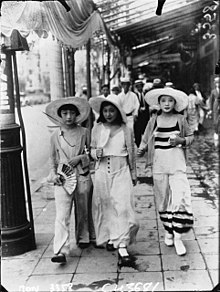 Modern girls wearing "Beach Pajama" style clothing walking down Ginza in 1928 | |
| Years active | Interwar |
|---|---|
| Country | Japan |
| Influences | Naomi |
Modern girls (モダンガール, modan gāru) (also shortened to moga) were Japanese women who followed Westernized fashions and lifestyles in the period after World War I.
Moga were Japan's equivalent of America's flappers, Germany's neue Frauen, France's garçonnes, or China's modeng xiaojie (摩登小姐).[1] By viewing moga through a Japanese versus Western lens, the nationalist press could use the modern girl archetype to blame such failings as frivolity, sexual promiscuity, and selfishness on foreign influence.[2] The period was characterized by the emergence of working class young women with access to money and consumer goods. Using aristocratic culture as their standard of Japaneseness, the critics of the modern girl condemned her working class traits as "unnatural" for Japanese. Modern girls were depicted as living in the cities, being financially and emotionally independent, choosing their own suitors, and apathetic towards politics.[3] The woman's magazine was a novelty at this time, and the modern girl was the model consumer, someone more often found in advertisements for cosmetics and fashion than in real life. The all-female Takarazuka Revue, established in 1914,[4] and the novel Naomi (1924) are outstanding examples of modern girl culture.
- ^ The Modern Girl Around the World: Consumption, Modernity, and Globalization, Edited by Alys Eve Weinbaum, Lynn M. Thomas, Priti Ramamurthy, Uta G. Poiger, Modeleine Yue Dong, and Tani E. Barlow, p. 1.
- ^ The Gender/Sexuality Reader: Culture, History, Political Economy, edited by Roger N. Lancaster and Micaela Di Leonardo, pp. 493-494
- ^ The 'Modern' Japanese Woman, The Chronicle 5/21/2004:
- ^ Makiko Yamanashi, The Takarasienne and Moga: Modernity in the Prewar Girls' Culture Archived April 13, 2015, at the Wayback Machine